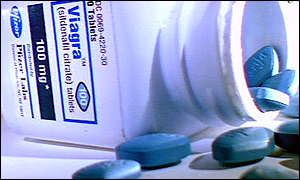 |
|
Drug Trials
Strong Stuff: How effective is Viagra? Statistics tell us that it is likely more effective that its advertising claims it to be. “VIAGRA has shown improvement in erectile function in 4 out of 5 men compared with 1 out of 4 for sugar tablets.” -Ad, Conde-Nast Traveler, June 2000 What do these statistics mean about the effectiveness of VIAGRA? (80-25=55%?) Actually, 55% is considerably lower than the true success rate of Viagra. A recent magazine ad for Viagra stated that 80% of those in an experiment who used Viagra reported improvement, as compared to 25% among those who had the placebo. The inclination is to subtract 25 from 80, and thus to estimate Viagra's true effectiveness as 55%. Such a calculation, however, is harsh on Viagra. Among the 80% of Viagra users who reported improvement, some physically benefited while the remainder improved for other reasons. If Q is the fraction of users directly helped by the drug, then Q could be approximated from the linear equation: Q + .25(1-Q) = .8 The idea here is that, like the users of the placebo, 25% of those who used Viagra but did not physically benefit from it nonetheless reported improvements. 25% of 20% = 5% 5% of users that reported Viagra was effective is the result of placebo effect. Hence 75% of Q plus 25% response as placebo effect equals the 80% that believed they were helped by Viagra. Q = .7333 ~= 73% The 80% of Viagra patients who reported gains included the 73% with physical benefits and about 1/4 of the remaining 27% without such benefits. Note that 73% is considerably higher than the 55% success rate that many readers might have inferred from subtracting 25% from 80%. See a graphical explanation of the mathematics Confused? Read the Frequently Asked Questions Thus, Viagra users essentially fall into three categories: 73% who benefit physically |
The Center for Experimental Pharmacology and Therapeutics, Harvard-MIT Division of Health Sciences and Technology is solely responsible for the content of this web course. Introduction
| Topics | Syllabus
| Instructors | DemoMaker
| Glossary | Library
|
